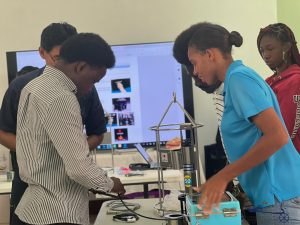The Department of Marine Resources (DMR) St. Kitts and Nevis received three underwater cameras and three depth gauges as part of a grant aid US$1.5 million project, courtesy of the Government of Japan through the Japan International Cooperation System (JICS) on the morning of Tuesday, 17th January 2023 at the Department’s Large Conference room.
 A brief but significant ceremony was held immediately after the handing over of equipment to launch the opening of the “Underwater Cameras and Depth Gauges Operation Training” workshop to help staff improve their underwater imaging skills while using the newly donated deep-sea technology.
A brief but significant ceremony was held immediately after the handing over of equipment to launch the opening of the “Underwater Cameras and Depth Gauges Operation Training” workshop to help staff improve their underwater imaging skills while using the newly donated deep-sea technology.
In his Opening remarks, the Director of the Department of Marine Resources, Dr. Marc Williams told the staff that he is positive that the 3-day training, which runs from January 17 to 19 will provide them with an abundance of knowledge and experience.
“We have not had any equipment like this to assist us with our work in the marine environment and I know that a number of you at DMR have been trained and are now certified as scuba divers but there are limits to the depth that you can dive. So these machines that we have here this morning will help. I think the maximum depth is 500 metres so we will see what type of coverage we can do”, the Director stated.
Meanwhile, the Acting Permanent Secretary in the Ministry of Agriculture, Fisheries, Marine Resources and Cooperatives, Miguel Fleming gave brief remarks about the government’s thrust to manage our marine habitats.
He explained, “I think this a major contribution.
The government of St. Kitts and Nevis believes that we can make a greater impact on the lives of the citizens of St. Kitts and Nevis by providing more information to fish consumers and the fishers who target the fish. Additionally, that same information would be used to improve the management of marine habitats and decision-making concerning fisheries resources. The cameras and the depth gauges will be used as tools for DMR staff researching marine life.
The underwater camera and depth gauge make it easy for the staff to check on the health and development of a given marine habitat.” He also highlighted how safety plays an important role in the acquisition of underwater equipment. “Given the volatile nature of the marine environment, the Department of Marine Resources did not want to expose the lives of the staff to too much risk in the form of diving to gather the required information.
These submersible cameras can go to depths humans cannot reach when they are diving because they offer the ability to see areas beyond the natural limits of where humans can dive. The cameras can discover new species or formations in the water that was previously undetected. Diving would still be necessary; however, the camera can enhance and supplement the work of the divers in some instances”, Mr. Flemming added.
Engineer, Masayuki (Mark) Aoki of the Global Project Department at NBK Corporation in Tokyo, Japan is the course facilitator.
A hands-on demonstration led by Mr. Aoki followed at the end of the session to provide the staff with a better understanding of the equipment.
The training will continue with a practical exercise on board the Department of Marine Resources Fisheries Patrol Vessel and wrap up with an ocean-deep sea tour later this week.
